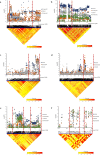Genome-wide association study reveals loci and candidate genes of flowering time in jute (Corchorus L.)
- PMID: 38009098
- PMCID: PMC10667207
- DOI: 10.1007/s11032-023-01435-8
Genome-wide association study reveals loci and candidate genes of flowering time in jute (Corchorus L.)
Abstract
Suitable flowering time can improve fiber yield and quality, which is of great significance for jute biological breeding. In this study, 242 jute accessions were planted in Fujian for 2 consecutive years, and 244,593 SNPs distributed in jute genome were used for genome-wide association analysis of flowering time. A total of 19 candidate intervals (P < 0.0001) were identified by using GLM and FaST-LMM and were significantly associated with flowering time, with phenotypic variation explained (PVE) ranging from 5.8 to 18.61%. Six stable intervals that were repeatedly detected in different environments were further identified by the linkage disequilibrium heatmap. The most likely 7 candidate genes involved to flowering time were further predicted according to the gene functional annotations. Notably, functional analysis of the candidate gene CcPRR7 of the major loci qFT-3-1, a key factor in circadian rhythm in the photoperiodic pathway, was evaluated by linkage, haplotype, and transgenic analysis. β-glucuronidase (GUS) and luciferase (LUC) activity assay of the promoters with two specific haplotypes confirmed that the flowering time can be controlled by regulating the expression of CcPRR7. The model of CcPRR7 involved in the photoperiod regulation pathway under different photoperiods was proposed. These findings provide insights into genetic loci and genes for molecular marker-assisted selection in jute and valuable information for genetically engineering PRR7 homologs in plants.
Supplementary information: The online version contains supplementary material available at 10.1007/s11032-023-01435-8.
Keywords: CcPRR7; Flowering time; GWAS; Jute.
© The Author(s), under exclusive licence to Springer Nature B.V. 2023. Springer Nature or its licensor (e.g. a society or other partner) holds exclusive rights to this article under a publishing agreement with the author(s) or other rightsholder(s); author self-archiving of the accepted manuscript version of this article is solely governed by the terms of such publishing agreement and applicable law.
Conflict of interest statement
Conflict of interestThe authors declare no competing interests.
Figures






Similar articles
-
Genome-wide association study and transcriptome analysis reveal natural variation of key genes regulation flowering time in rapeseed.Mol Breed. 2024 May 18;44(6):40. doi: 10.1007/s11032-024-01479-4. eCollection 2024 Jun. Mol Breed. 2024. PMID: 39678222 Free PMC article.
-
A genome-scale integrated approach aids in genetic dissection of complex flowering time trait in chickpea.Plant Mol Biol. 2015 Nov;89(4-5):403-20. doi: 10.1007/s11103-015-0377-z. Epub 2015 Sep 22. Plant Mol Biol. 2015. PMID: 26394865
-
Multi-omics provides new insights into the domestication and improvement of dark jute (Corchorus olitorius).Plant J. 2022 Nov;112(3):812-829. doi: 10.1111/tpj.15983. Epub 2022 Oct 8. Plant J. 2022. PMID: 36129373
-
Genome-wide association study of heading and flowering dates and construction of its prediction equation in Chinese common wheat.Theor Appl Genet. 2018 Nov;131(11):2271-2285. doi: 10.1007/s00122-018-3181-8. Epub 2018 Sep 14. Theor Appl Genet. 2018. PMID: 30218294 Review.
-
Genome-wide association study reveals novel quantitative trait loci and candidate genes of lint percentage in upland cotton based on the CottonSNP80K array.Theor Appl Genet. 2022 Jul;135(7):2279-2295. doi: 10.1007/s00122-022-04111-1. Epub 2022 May 16. Theor Appl Genet. 2022. PMID: 35570221 Review.
Cited by
-
Genome-wide association study and transcriptome analysis reveal natural variation of key genes regulation flowering time in rapeseed.Mol Breed. 2024 May 18;44(6):40. doi: 10.1007/s11032-024-01479-4. eCollection 2024 Jun. Mol Breed. 2024. PMID: 39678222 Free PMC article.
References
-
- Choudhary SB, Saha D, Sharma HK, Chowdhury I, Kumar AA, Jambhulkar SK, Mitra J. Transcriptional analysis of a delayed-flowering mutant under short-day conditions reveal genes related to photoperiodic response in tossa jute (Corchorus olitorius L.) Ind Crops Prod. 2019;132:476–486. doi: 10.1016/j.indcrop.2019.03.001. - DOI
LinkOut - more resources
Full Text Sources

